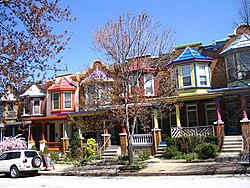Charles Village
| Charles Village | |
|---|---|
| Neighborhood | |
| Country | United States |
| State | Maryland |
| City | Baltimore |
| Established | 1897 as Peabody Heights 1967 as Charles Village |
| Population (2010) | |
| • Total | 8,267 |
| Demonym(s) | Charles Villager |
| Time zone | Eastern (UTC-5) |
| • Summer (DST) | EDT (UTC) |
| ZIP code | 21218 |
| Area code | 410, 443, and 667 |
| Website | http://charlesvillage.net/ |
|
Charles Village-Abell Historic District
|
|

Guilford Avenue rowhouses
|
|
| Location | Roughly bounded by University Parkway, Guilford Ave., and 25th, Mace, Charles, and Barclay Sts., Baltimore, Maryland |
| Coordinates | 39°19′27″N 76°36′55″W / 39.32417°N 76.61528°WCoordinates: 39°19′27″N 76°36′55″W / 39.32417°N 76.61528°W |
| Area | 175 acres (71 ha) |
| Built | 1868 |
| NRHP Reference # | 83003629 |
| Added to NRHP | December 15, 1983 |
Charles Village is a neighborhood located in the north-central area of Baltimore, Maryland, USA. It is a middle-class area with many single-family homes that is in proximity to many of Baltimore's urban amenities. The neighborhood began in 1869 when 50 acres (200,000 m2) of land were purchased for development. The land was divided and turned over to various builders who constructed home exteriors, leaving the interiors to be custom built according to buyer specifications. The area was first developed as a streetcar suburb in the early 20th century, and is thought to be the first community to employ tract housing tactics. At the time, the area was known as Peabody Heights; the moniker Charles Village, derived from Charles Street, the area's major north-south corridor, was coined in the 1970s as the beginning of a process of conceptually grouping a large and somewhat heterogeneous area. The neighborhood history has been researched and published by Gregory J. Alexander and Paul K. Williams in their book Charles Village: A Brief History (The History Press, 2009).
Charles Village in a strict sense consists of the area immediately to the east and south of the Johns Hopkins University Homewood campus. However, smaller neighborhoods to the east of this area — including Abell and Harwood, are considered by residents and other Baltimoreans to be part of Greater Charles Village. The Charles Village Community Benefits District (CVCBD) covers a hundred-block area generally bounded by 33rd Street to the north, Greenmount Avenue to the east, 25th Street (east of Guilford) and 20th Street (west of Guilford) to the south, and Johns Hopkins and Howard Street to the west. This area contains over 14,000 people and 700 businesses. The Charles Village Community Benefits District Management Authority (CVCBDMA) is a public entity that provides services within the CVCBD.
One of the Charles Village's defining features is its proximity to Johns Hopkins Homewood Campus. Many of the university's staff and students live in the neighborhood, particularly in the areas immediately adjacent to the campus. Perhaps as a result, Charles Village has for the past several decades attracted a large population of artists and bohemians. The area also has a reputation for being one of the more racially diverse neighborhoods in a city that was largely segregated for decades. The neighborhood in general becomes more affluent as you travel from south to north and from east to west.
...
Wikipedia



